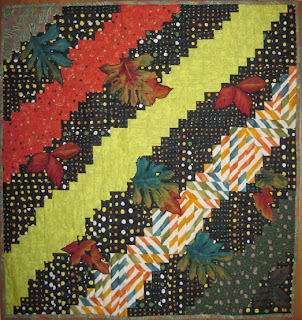Quilters are often surprised when they see Broderie Perse applique quilts up close. You can see that the blue-gray leaves are not cut close to the outline, but cut rather loosely into the white background.
Once you see that the cutting isn't quite as close as it looks in a photograph, you realize that the technique is not all that difficult.
Of course, SOME people like M.L.D, above, cut her florals and stems very closely in 1853. This makes it harder to cut, manage and sew.
The peacock's feet and perch are cut
freely from the white background.
The secret to making Broderie Perse relatively simple is to match the background color of both the chintz floral and the background fabric carefully.
That's easy when both backgrounds are white.
But it's not always easy to find matching backgrounds. See the blobby shape on the left which was a tan ground chintz. It just didn't work. If she was going to use a darker background she should have cut carefully around each rose as the quilter below did.
It looks like the backgrounds for her florals were brown so she had to snip close to the flower and do a lot more work.
Here's another antique quilt with leaves and flowers apparently cut from a dark background. The seamstress used a blanket or button-hole stitch to secure the applique, a relatively common technique.
The Sarah Morrell album quilt, which alternates pieced blocks and Broderie Perse blocks
Di Ford has done patterns for a reproduction from this mid-1840 quilt. Two bloggers from the Netherlands are posting their progress. Click on their blogs to see more of the process:
http://www.supergoof.web-log.nl/
And see this Secret Sewing Sisterhood blog:
http://secretsewingsisterhood.blogspot.com/2010/07/daughters-of-sarah-morrell.html
Traditional Broderie Perse is harder today because large-scale florals with white backgrounds are rare.
The lack of white background chintzes may be why the technique fell out of favor after the Civil War, when chintzes gained a "chintzy" reputation. But it is still possible to match backgrounds. Just forget white.
"Ohio Autumn" from my Moda collection Arnold's Attic
When planning to do Broderie Perse, pick out the large-scale floral, then find a color match for the background. Arnold's Attic has close color matches in small-scale prints for the shades in the large leaf print.
Occasionally designers do you a huge favor and give you a large-scale floral with a fancy background pattern PLUS yardage of the same fancy background pattern, as Kaye England did several years ago. Judy Severson made great use of Kaye's two prints---chintz print and matching background in this Broderie Perse quilt below.
See more about Judy's broderie perse quilts at a post I did earlier this year. Click here: http://siputflash.blogspot.com/2010/01/judy-seversons-broderie-perse.html
One of the best ways to do contemporary Broderie Perse is to focus on black. Black-ground chintzes are easy to find today (although they were NEVER a traditional print style because blacks for cotton were not practical until about 1890.)
Roseanne Smith is making a Broderie Perse on black quilt. Here's a block with flowers cut out and arranged on a new background. She's ready to needleturn applique it.
Here's her leftovers. You can see she could cut general shapes because her blacks match so closely.
Here's one of her finished blocks.
This little quilt by Sujata Shah makes the most of matching blacks. That's just a strip of black-ground floral stitched above the vase. See Sujata's blog by clicking here: http://therootconnection.blogspot.com/
Logs and Leaves by Bobbi Finley
Bobby appliqued leaves cut from a dark ground print to her dark log cabin blocks.
If you've been doing Broderie Perse I'd love to see photos---in progress or finished.
















Tidak ada komentar:
Posting Komentar